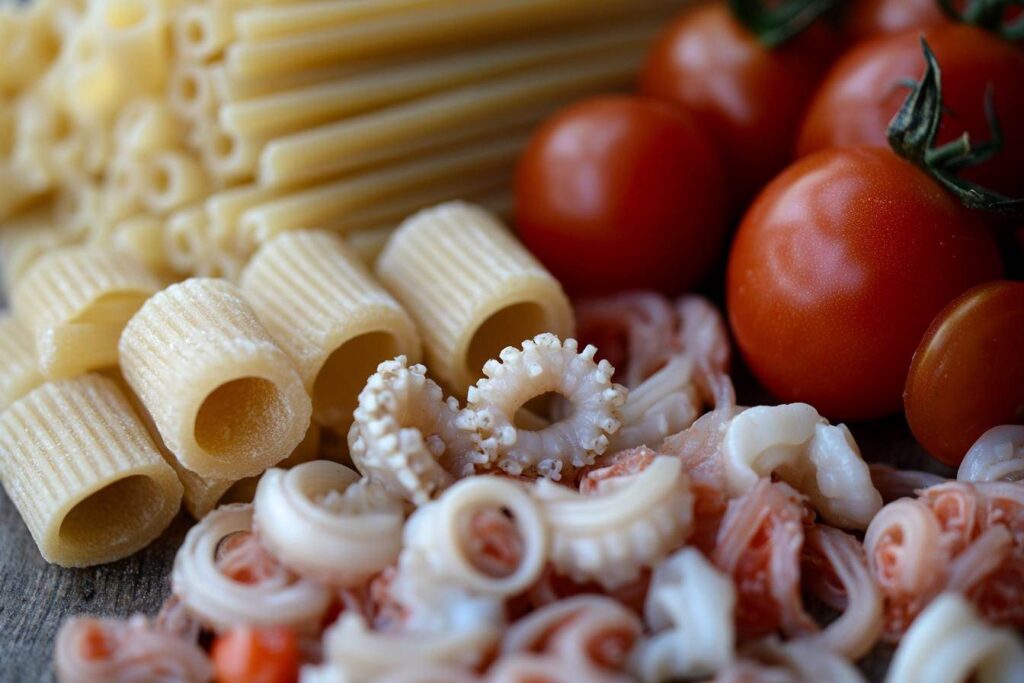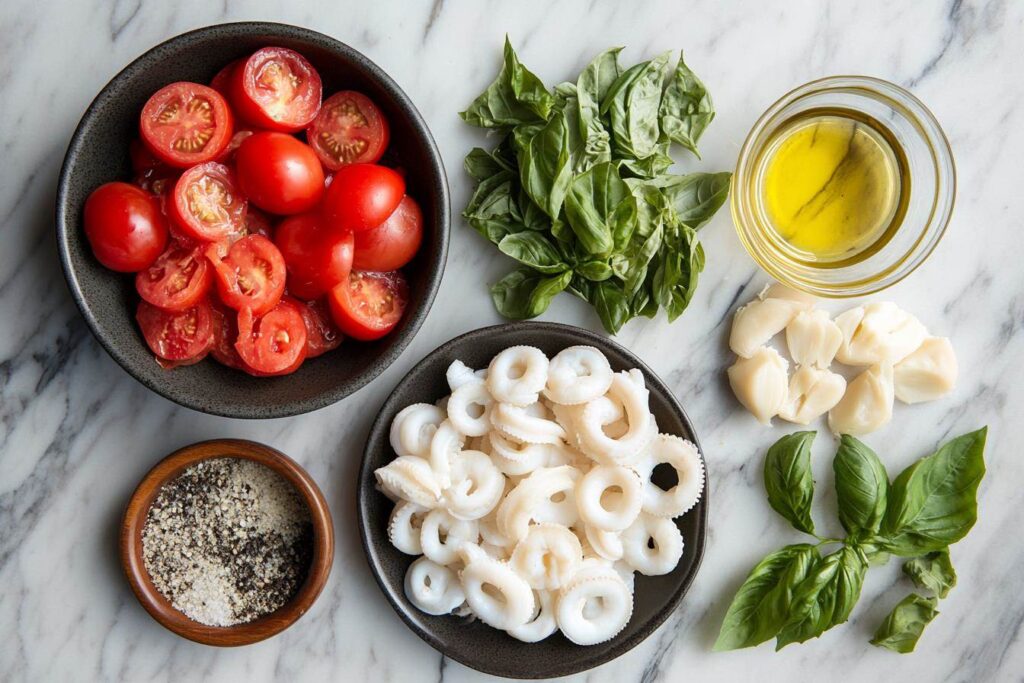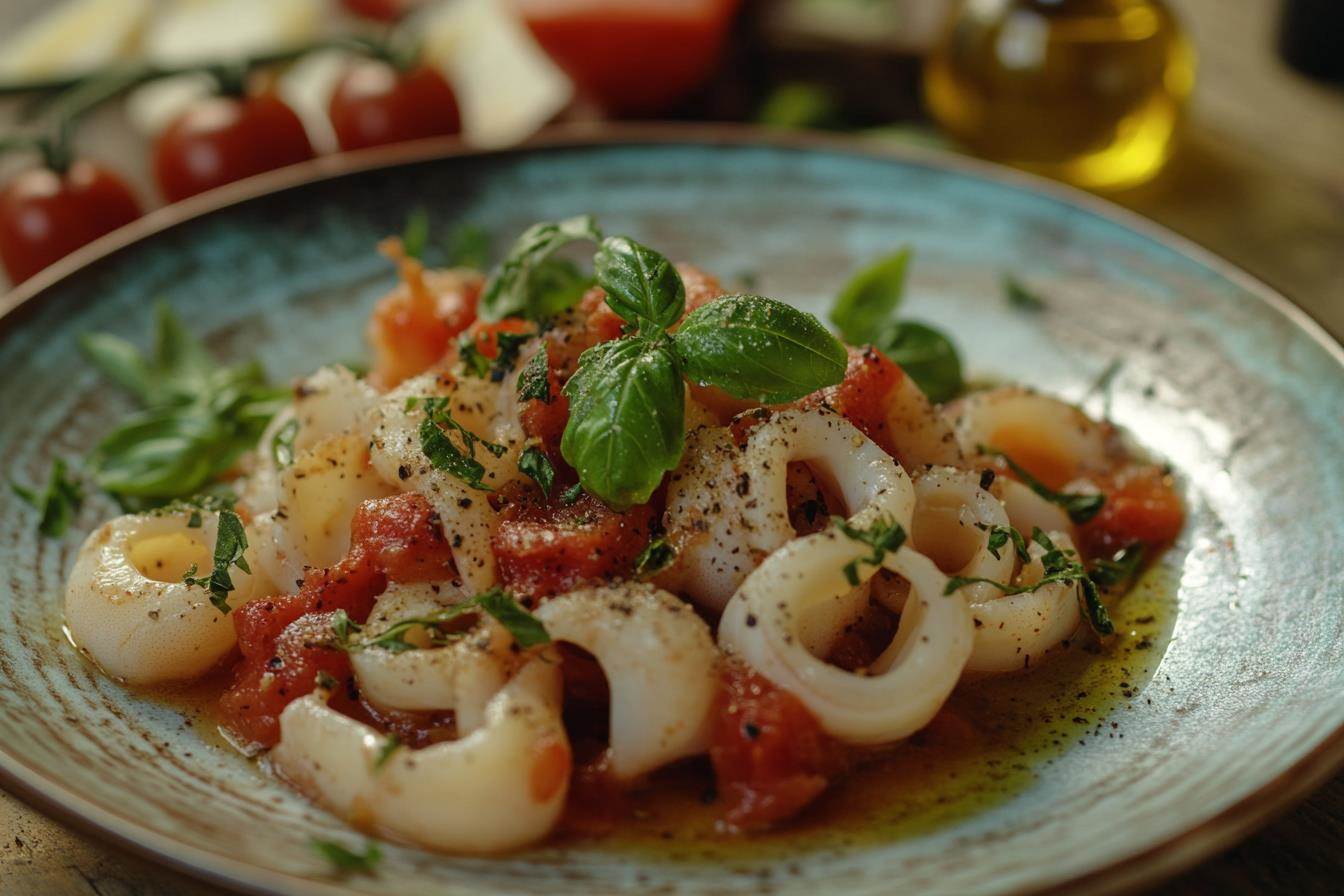Calamarata, a traditional pasta dish deeply rooted in Italian cooking heritage, is more than just a meal—it’s an experience. Shaped like calamari rings, this pasta is a delightful blend of texture, flavor, and history. In this guide, we’ll dive into the origins of calamarata, its unique features, recipes, and tips for perfecting it at home. Whether you’re a seasoned chef or a home cook looking to try something new, this article will inspire and educate.
Introduction to Calamarata
What is Calamarata?
Calamarata, named for its resemblance to calamari rings, is a type of pasta hailing from the Campania region of Italy. Its unique tubular shape pairs gracefully with seafood, particularly calamari, creating a dish that’s as visually striking as it is delicious. What sets calamarata apart, though, is its ability to soak up rich sauces while maintaining its al dente texture.
This pasta is crafted using durum wheat semolina, ensuring a hearty bite and excellent sauce absorption. It’s often paired with tomato based sauces, olive oil, and fresh herbs. Whether served with seafood or vegetarian accompaniments, calamarata pasta is a versatile staple in Italian cuisine.
Origins and History of Calamarata
The history of calamarata is steeped in tradition, particularly in Naples and nearby coastal areas. This dish reflects Italy’s love for combining fresh, local components with artistry. The use of calamari in its preparation stems from the Mediterranean’s abundance of seafood, which has shaped Italian recipes for centuries.
Interestingly, the pasta’s shape wasn’t purely aesthetic—it was designed to emulate calamari rings to complement seafood-centric dishes. Over time, its popularity spread beyond Naples, becoming a beloved choice for families across Italy and around the world.

Understanding Calamarata Pasta
Shape and Texture
Calamarata pasta is instantly recognizable due to its unique shape. Designed to mimic calamari rings, it features short, thick tubes with smooth edges. This cylindrical design not only resembles seafood but also allows sauces to cling to its surface, ensuring every bite is flavorful and satisfying.
Made predominantly from durum wheat semolina, calamarata boasts a firm texture that holds its shape during cooking. This makes it ideal for rich, hearty sauces. When cooked al dente, its chewy bite enhances the dining experience, creating a contrast to the tender calamari often served alongside it.
How Calamarata Differs from Other Pasta Types
At first glance, calamarata may seem similar to other tubular pastas like rigatoni or paccheri, but its subtle differences set it apart. Calamarata is shorter and thicker than most tubular pasta, providing a distinctive mouthfeel.
Another notable distinction is its cooking purpose. While other pastas are versatile across cuisines, calamarata has a niche role in seafood dishes, particularly those inspired by Mediterranean cuisine.
Additionally, calamarata excels at balancing sauce distribution. Unlike wider varieties like paccheri, which can sometimes overpower delicate flavors, calamarata harmonizes the dish by subtly soaking up sauce without losing its identity. This ensures that every ingredient—pasta, sauce, and seafood—shines through in perfect unison.
Traditional Calamarata Recipe
Ingredients Needed
Creating a classic calamarata dish requires simple, high quality components that celebrate Italian cooking tradition. Here’s what you’ll need for a traditional seafood based calamarata recipe:
- Calamarata pasta: 400g of authentic durum wheat pasta for a hearty texture.
- Calamari: 300g of fresh calamari rings, cleaned and ready to cook.
- Tomatoes: 500g of ripe cherry or plum tomatoes, peeled and diced.
- Garlic: 2-3 cloves, finely chopped for a bold, aromatic base.
- Olive oil: 4 tablespoons of extra virgin olive oil for richness and depth.
- White onion: Half an onion, finely diced to complement the garlic.
- Fresh herbs: Basil and parsley, chopped, to add quality to the dish.
- Chili flakes: A pinch for choice heat, enhancing the flavors of the sauce.
- Salt and pepper: To taste, for seasoning.
Step-by-Step Preparation Guide
- Prepare the calamari: Clean the calamari thoroughly, ensuring all membranes and insides are removed. Cut into uniform rings, resembling the pasta’s shape, and pat them dry.
- Cook the pasta: In a large pot of salted boiling water, cook the calamarata pasta until it’s al dente. Reserve a cup of pasta water for later use.
- Sauté the aromatics: Heat olive oil in a large pan over medium heat. Add the chopped garlic and onion, cooking until fragrant and slightly golden. Be careful not to burn the garlic—it can turn bitter!
- Prepare the sauce: Add the diced tomatoes to the pan, stirring to combine with the garlic and onion. Season with salt, pepper, and chili flakes if desired. Simmer for about 10 minutes until the tomatoes break down into a rich sauce.
- Cook the calamari: Add the calamari rings to the sauce, stirring gently. Cook for 5-7 minutes, ensuring the calamari is tender but not overcooked, which can make it rubbery.
- Combine the pasta and sauce: Drain the pasta and transfer it to the pan with the sauce. Add a splash of the reserved pasta water to help the sauce coat the pasta evenly. Stir until the calamarata is fully coated and infused with the flavors of the sauce.
- Garnish and serve: Sprinkle the dish with fresh basil and parsley, and serve immediately. Pair it with crusty bread to soak up the remaining sauce!

Variations of Calamarata Dishes
While the traditional seafood version of calamarata holds a special place in Italian cuisine, this versatile pasta can be adapted to suit various tastes and dietary preferences. From rich seafood combinations to hearty vegetarian and meat-based options, the possibilities are endless. Let’s explore some popular variations that highlight the adaptability of this iconic dish.
Calamarata with Seafood Mix
For seafood lovers, calamarata with a mix of ocean treasures is an irresistible option. Alongside calamari rings, this variation includes components like shrimp, mussels, and clams. The seafood is gently sautéed with garlic, olive oil, and chili flakes before being simmered in a tomato-based sauce.
Adding a splash of seafood stock enhances the dish’s depth, infusing the pasta with an unmistakable taste of the Mediterranean. A sprinkle of fresh parsley ties it all together. The result? A hearty, flavorful pasta dish that’s a celebration of coastal flavors.
Vegetarian Calamarata Options
For those seeking plant-based alternatives, vegetarian calamarata is a delightful choice. Instead of seafood, this version features roasted vegetables like zucchini, eggplant, and bell peppers.
The veggies are tossed with garlic and olive oil, then combined with a rich tomato or creamy pesto sauce. For added texture, a handful of toasted pine nuts or crispy chickpeas works wonders. Garnish with fresh basil for a vibrant and healthy dish that showcases the pasta’s versatility.
Calamarata with Meat Sauces
Calamarata isn’t just limited to seafood or vegetables—it pairs gracefully with robust meat sauces. A classic choice is a slow-cooked beef ragù, where tender chunks of meat are simmered with tomatoes, red onions, and Italian herbs.
Alternatively, ground sausage or lamb can be browned and then added to a spicy tomato sauce, creating a bold, hearty flavor. Moreover, calamarata pasta absorbs these rich sauces perfectly, ensuring every bite is packed with meaty goodness. Consequently, these variations are ideal for those who prefer a protein-rich, comforting meal.
Cooking Techniques for Perfect Calamarata
Crafting the perfect calamarata dish requires more than just a recipe; it’s an art that relies on attention to detail and proper technique. From picking quality ingredients to perfecting cooking techniques, every step plays a vital role in creating a dish that truly delights. Let’s delve into the techniques that elevate this pasta dish from good to unforgettable.
Selecting Quality Ingredients
The foundation of any great calamarata lies in the quality of its components. To begin with, use authentic calamarata pasta made from 100% durum wheat semolina. Furthermore, its firmness and ability to hold sauces are essential to its appeal.
Fresh calamari is equally important. Look for squid that is firm, with a mild, clean scent. If fresh isn’t available, frozen calamari can be a good replace just ensure it’s thawed properly.
For the sauce, ripe, juicy tomatoes and high quality olive oil are non negotiable. Opt for fresh garlic, fragrant basil, and a pinch of chili flakes to enhance the flavors. Remember, the simpler the recipe, the more important it is to use ingredients that shine on their own.
Tips for Cooking Calamari
Cooking calamari can be tricky, as it tends to turn rubbery if not handled correctly. The golden rule? Keep it quick or go long calamari should be cooked for no more than 5-7 minutes or slow cooked for an hour to regain tenderness.
Start by cleaning the calamari thoroughly, removing the beak, quill, and membranes. Cut it into even rings to ensure uniform cooking. When sautéing, use high heat and a touch of olive oil. Add the calamari to the pan only when the oil is hot, and cook it until it just turns opaque.
Achieving the Ideal Pasta Texture
Perfect pasta texture is all about timing and technique. Always cook calamarata al dente, as overcooking can cause it to lose its firm bite and sauce holding ability.
Start by boiling water with plenty of salt—about a tablespoon per liter of water. Adding salt after the water boils ensures it dissolves quickly and seasons the pasta evenly.
Keep a close eye on the cooking time, often listed on the package. Test the pasta a minute before the suggested time to ensure it’s cooked but still firm. After cooking, reserve some pasta water before draining. Add this starchy liquid to the sauce to create a silky, cohesive texture.

Pairing Calamarata with Sides and Complementary Flavors
Pairing calamarata with the right accompaniments elevates the dining experience, enhancing its flavors and creating a healthy meal. While drinks are part of traditional matches, looking at sides and matching dishes highlights the rich flavors, bold flavors of calamarata to shine even brighter. From fresh salads to rustic bread, there are plenty of options to round out your meal.
Complementary Side Dishes
When serving calamarata, the right side dishes can enhance the meal’s flavors while providing variety.
- Fresh green salad: A light salad with arugula, spinach, and a lemon vinaigrette complements the richness of the dish without overwhelming it. Add a sprinkle of shaved Parmesan for extra flair.
- Garlic bread: Warm, crusty garlic bread is perfect for soaking up the flavorful sauce, ensuring nothing goes to waste.
- Roasted vegetables: Oven-roasted zucchini, eggplant, or bell peppers seasoned with olive oil and Italian herbs make an excellent accompaniment.
- Simple antipasti: Offer marinated olives, artichoke hearts, or a light caprese salad for a touch of Italian tradition.
Calamarata in Italian Culture
Regional Significance in Naples
Calamarata is a classic dish in Neapolitan cuisine, as it represents the region’s deep connection to the sea. Specifically, its origins trace back to coastal Naples, where fresh seafood has always been a culinary cornerstone. Moreover, calamarata pasta resembles calamari rings by design, effectively celebrating the plenty of squid in the Mediterranean waters.
In Naples, the dish is a staple of family gatherings and festive occasions, showing the Italian tradition of using food to bring people together. It’s often served during special celebrations, particularly in homes where seafood plays a central role. The simplicity of the recipe, combined with the freshness of local ingredients, perfectly encapsulates the essence of Naples’ cooking heritage.
Calamarata in Italian Cuisine
Outside Naples, calamarata is known as a symbol of Italian cooking skill. Its flexibility has also helped it fit into different regional styles, like Ligurian pesto versions and Sicilian recipes with capers and olives.
In Italian cooking, calamarata shows a mix of tradition and creativity. Many chefs stick to the classic recipe, but others try new sauces and ingredients to show the pasta’s flexibility. Its special shape and ability to soak up flavors make it popular in restaurants and homes, both in Italy and around the world.
Nutritional Information
Calamarata Pasta Nutrition Facts
Calamarata pasta is a healthy food, mainly made from durum wheat semolina, which is high in carbs and gives long-lasting energy. A typical 100-gram serving includes about:
- Calories: 350
- Protein: 12g
- Carbohydrates: 70g
- Fiber: 3g
- Fat: 1g
Its low-fat content makes it a lighter choice than other types of pasta. Adding seafood or veggies in traditional recipes makes it even healthier, giving important nutrients like omega3s, vitamins, and minerals.
Health Benefits and Considerations
When made with care, calamarata dishes can be a good part of a balanced diet. Olive oil and fresh ingredients follow the basics of the Mediterranean diet, known for its heart benefits
The dish provides a good amount of fiber and protein, especially when served with seafood or beans. But people watching their carb intake should pay attention to portion sizes. Choosing whole-grain calamarata or adding more veggies can boost its fiber, making it even healthier.
For individuals with gluten issues, calamarata pasta without gluten options are now widely available, ensuring everyone can enjoy this classic dish. With its rich flavors and nutritional benefits, calamarata is a meal that fulfillsboth the palate and the body.
Making Calamarata Pasta at Home
Homemade Pasta Recipe
Making calamarata pasta from scratch is a rewarding way to experience the dish. Here’s a simple recipe:
Ingredients:
- 2 cups durum wheat semolina
- ¾ cup warm water
- Pinch of salt
Steps:
- On a clean surface, form the semolina into a mound and create a well in the center.
- Gradually pour warm water into the well, mixing it with the flour using your fingers or a fork.
- Add a pinch of salt and knead the dough for about 10 minutes until it becomes smooth and elastic.
- Wrap the dough in plastic wrap and let it rest for 30 minutes.
- Roll the dough out into a thin sheet and cut it into wide strips (2-3 cm), forming short, thick tubes to resemble calamari rings.
- Let the pasta dry for an hour before cooking.
FAQs About Calamarata
What is the origin of Calamarata pasta?
Calamarata pasta comes from Naples, a city renowned for its vibrant coastal cuisine. The pasta’s design, shaped like calamari rings, shows the region’s strong connection to the Mediterranean Sea. Local fishermen traditionally paired their fresh squid catch with pasta, giving rise to this iconic dish.
How do you prevent calamari from becoming rubbery?
To keep calamari tender, you need to follow the “quick or slow” rule. Either cook it quickly over high heat for 5-7 minutes or braise it gently for at least 30 minutes. Anything in between results in a tough, rubbery texture.
Can Calamarata be made without seafood?
Of course! While often served with squid or other seafood, calamarata works well for plant based or meat based options. Those who prefer plant based meals can swap seafood for roasted veggies like zucchini, eggplant, or bell peppers.
For a richer flavor, consider pairing the pasta with creamy sauces such as pesto or a hearty mushroom ragù. These options maintain the dish’s bold and satisfying qualities without seafood.
What sauces pair best with Calamarata pasta?
Chefs traditionally serve calamarata pasta with tomato based seafood sauces, but it also pairs well with several other options:
- Tomato-basil sauce for a simple, classic flavor.
- Garlic and olive oil with a pinch of chili flakes for a light yet flavorful dish.
- Vegetable-based sauces like eggplant caponata for a vegetarian twist.
The key is to use sauces that complement the pasta’s ability to soak up flavor.
Is Calamarata pasta available gluten-free?
Yes, calamarata pasta without gluten is easy to find and works well for those with gluten issues or celiac disease. In fact, makers often use options like rice flour, corn flour, or chickpea flour to create these versions. As a result, they provide a similar feel and taste to regular pasta.
When purchasing gluten-free options, check the packaging for proper cooking instructions, as they may differ slightly from standard pasta.
How should leftover Calamarata be stored and reheated?
o store leftover calamarata, put it in a sealed container and place it in the fridge within two hours of cooking. You can keep it safely for up to three days.
When reheating, use a skillet rather than a microwave for better results. Add a splash of water or olive oil to the pan to rehydrate the pasta and sauce. Heat it gently over medium heat, stirring occasionally, until warmed through. This method prevents the pasta from becoming dry or rubbery.
Recap of Key Points
Calamarata is more than just a pasta dish; in fact, it’s a celebration of Italian cooking tradition. Moreover, its origins in Naples show the area’s strong connection to the Mediterranean. At the same time, its unique ring shape, similar to squid, clearly shows its seafood roots. From traditional recipes with squid to creative options with veggies or meat sauces, calamarata offers endless variety.


1 thought on “Calamarata: The Ultimate Guide to This Iconic Italian Pasta Dish”